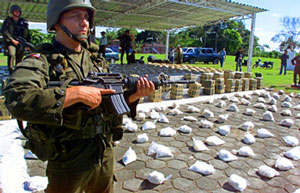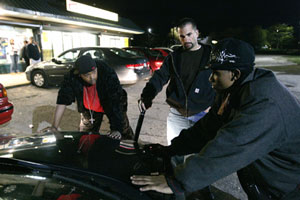ASKIAM
Senior Correspondent
- Secret ties between CIA, drugs revealed (FCN, 1996/2006)
- 25-year ‘war on drugs’ gets a failing grade (FCN, 12-22-2004)
- Drug War Clock (DrugSense.org)

WASHINGTON (FinalCall.com) – In addition to the strategic, diplomatic,and military failures of the U.S. war-policies in Iraq and Afghanistan, there is now another failure to be acknowledged by the Bush administration: the complete failure of the “War on Drugs.”
Since President Richard Nixon launched the war on drugs, and President Ronald Reagan re-dedicated it, billions of dollars have been spent with little positive effect. Worldwide drug use is up, criminals are making bigger profits than ever before, and in this country, Blacks, the poor, and urban dwellers are victims of a policy that seems to be aimed at the literal destruction of an entire generation of youth with drugs.
What the war did do was help quadruple the size of the nation’s prison population from 1980 to 2005, with urban Blacks and Latinos hardest hit–a dramatically disproportionate result of the different networks that developed to distribute drugs. According to data collected by the federal government, Blacks make up just 13 percent of the nation’s illicit drug users, but they are 32 percent of those arrested for drug violations and 53 percent of those incarcerated in state prisons for drug crimes.
The never-ending flow of drugs, and the disparity in punishment for drug offenses, are leading an increasing number of judges and attorneys to the conclusion that the nation’s fight against drug use, through the criminal justice system, will not, by itself, get the job done.
“The war on drugs is the underlying cause of (nearly all) misery. Everywhere, that is, except Washington, where a powerful bipartisan consensus has turned the issue into a political third rail,” author Misha Glenny, a former BBC correspondent and the author of “McMafia: A Journey Through the Global Underworld,” wrote in The Washington Post Aug. 19. But U.S. leaders prefer to blame other countries and their leaders for their failures.
Internationally, when the UN General Assembly got involved with a Special Session on drugs convened in 1998, it committed to “eliminating or significantly reducing the illicit cultivation of the coca bush, the cannabis plant and the opium poppy by the year 2008”, and to “achieving significant and measurable results in the field of demand reduction.” But 10 years after that initiative, global production and consumption of those drugs are roughly the same as they were a decade ago. At the same time, many producers have become more efficient, and cocaine and heroin have become purer and cheaper.

In Afghanistan, despite the presence of 35,000 U.S.-led NATO troops, “the drug trade is going gangbusters. According to the UN Office on Drugs and Crime (UNODC), Afghan opium production in 2006 rose a staggering 57 percent over the previous year. Next month, the United Nations is expected to release a report showing an additional 15 percent jump in opium production this year, while highlighting the sobering fact that Afghanistan now accounts for 95 percent of the world’s poppy crop,” wrote Ms. Glenny.
But the illegal narcotics industry isn’t limited to Afghanistan. The business is booming in Africa, the Middle East, South America and across the United States.
The U.S. “war” on drugs is doing everything wrong. Instead of concentrating on eradicating drug supplies abroad, and criminalizing its use at home, “decades of research have shown that the most cost-effective way to undermine drug markets and reduce drug abuse is not by providing foreign aid to other countries, but making a greater commitment to reducing drug misuse at home. Funding effective drug treatment provides a far better return on investment than does any form of international drug control,” according to Ethan Nadelmann writing in The LA Times.
Economist Milton Friedman made a similar point in a letter to President George H.W. Bush’s first drug czar, William J. Bennett: “Of course the problem is demand, but it is not only demand, it is demand that must operate through repressed and illegal channels. Illegality creates obscene profits that finance the murderous tactics of the drug lords; illegality leads to the corruption of law enforcement officials; illegality monopolizes the efforts of honest law forces so that they are starved for resources to fight the simpler crimes of robbery, theft and assault.
“Drugs are a tragedy for addicts. But criminalizing their use converts that tragedy into a disaster for society, for users and nonusers alike. Our experience with the prohibition of drugs is a replay of our experience with the prohibition of alcoholic beverages.”
World-wide drug interdiction strategies have not been at all effective. In the United Kingdom, law enforcement agencies seize less than 20 percent of the 700 tons of cocaine and 550 tons of heroin produced annually. According to a recent report, they would have to seize 60 to 80 percent to make the industry unprofitable for the traffickers. On the other hand, the syndicates that control narcotics production and distribution are very profitable, with an annual turnover of $400 billion to $500 billion.
But U.S. policy has been concentrated on singling out, petty drug street peddlers, filling the jails with Black and Latino youth, confined according to strict “mandatory minimum” sentencing guidelines, rather than at rich drug lords at the top of the pyramids.

The case of 92-year old Kathryn Johnston, is typical, except for her age. Ms. Johnston died during a November 2006 police raid when she mistook a team of narcotics officers for criminal intruders. When the police broke down her door, she met them with an old pistol. They opened fire, and killed her.
An investigation revealed that almost everything leading up to and shortly after Ms. Johnston’s death were beset with lies, planted evidence, and cover-up on the part of the narcotics officers. They fabricated an imaginary informant to get the search warrant for Ms. Johnston’s home. They planted evidence on a convicted felon, arrested him, then let him off in exchange for his tip–which he made up–that they’d find drugs in Ms. Johnston’s house. Even when they realized their mistake, they tried to portray an innocent old woman as a drug dealer. They planted marijuana in Ms. Johnston’s basement, while she lay handcuffed and bleeding on the floor.
Further investigations in that case revealed that this behavior is common among narcotics officers in the Atlanta Police Department. Such behavior is common throughout the country.
Yet, the arrests of petty drug criminals–what one Chicago police officer described as the “mushroom effect: pull one out and several more pop up in its place”–persist all over the nation.
At the same time, the federal government has shown itself willing to actually engage in drug-running, in order to achieve its policy goals. In the late 1980s, during the Reagan administration, White House operative and Marine Lt. Col. Oliver North, headed an operation which traded drugs for money with which guns were purchased to aid anti-Sandanista Nicaraguan rebels in their fight to overthrow that government, which the Reagan administration opposed. A vast drug operation was exposed, when the details of the “Iran-Contra” arms sale became known.












